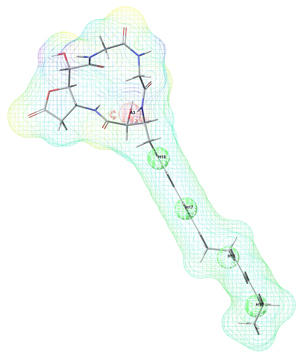A cyanobacterial lipopeptide selectively targets eukaryotic membranes
Researchers in TSG have, together with collaborators in Helsinki, identified a novel class of cyclic lipopeptides, named Anabaenolysin after the producing cyanobacterium, Anabaena. The lipopeptides have two glycines, two unusual amino acids, where one contains and a long unsaturated fatty acid chain. Their structures enable them to penetrate into membranes, but preferably membranes containing cholesterol.

Main content
When cells are treated with Anabaenolysin (Abl), their outer membrane is completely lysed, as are most of the membrane-enclosed organelles. However, mitochondria were unaffected and functional. Whereas eukaryotic membranes contain about 30% cholesterol, the mitochondria contain less than 5%. This cholesterol-dependence was confirmed using liposomes with or without cholesterol. Molecular modelling showed that Abl align well with cholesterol, and probably creates local disruptions of the membrane.
An interesting feature with Abl was that they could at subtoxic concentrations mediate transport of dyes or toxins across the membrane without killing the cells. We successfully managed to load cells with propidium iodide and even GFP-encoding plasmids and keep the cells viable.
This work describes the action of a bacterial natural compound apparently designed towards eukaryote membranes, and gives new insight on how natural detergents act on biological membranes. The article on isolation and identification of Abl was recently published in PLoS ONE, and their bioactivity on membranes in BBA-Biomembranes.
